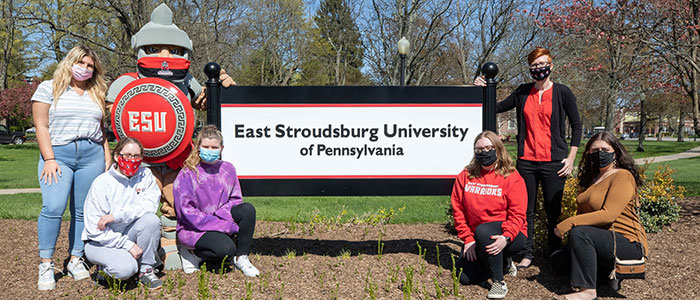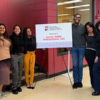ESU Students Chart Mask-Wearing

Posted by: Elizabeth Richardson on May 7, 2021, No Comments
Once a week during spring semester, East Stroudsburg University junior Georgia Murray would sit outside Koehler Fieldhouse for an hour making notes on how many people wore a mask as they entered or left the building.
Murray was one of 10 ESU students taking part in a U.S. Centers for Disease Control and Prevention study that is looking at mask-wearing on 53 college campuses around the country. ESU’s participation is led by Dr. Christine M. Fisher, assistant professor in the health studies department, who recruited students to take part.
Due to the pandemic, the normally bustling campus wasn’t crowded. Most ESU classes this spring were virtual but some lab and health science courses were in-person because of the hands-on requirements of the curricula. Six spring sports, plus men’s and women’s cross-country teams and the women’s swimming team, all competed this spring as well.
With 10 weeks of data collected, Fisher said they observed 92 percent compliance with the mask mandate on campus in the 10 locations students surveyed. Study results showed the majority of masks worn were cloth (56%) followed by paper surgical (37%). The same percentage used them correctly with both mouth and nose covered.
To participate in the study known as MASCUP, Murray and the other students had to complete online CDC training on how to conduct the observational survey and earn certification in maintaining the ethics of such research.
Murray, from Pocono Pines, Pa., said she switched her major to public health after falling in love with the subject during a class and plans to go to graduate school and eventually pursue a career in health care administration. She viewed the CDC study as both interesting and a good experience to further her goals.
“In the public health field, data collection is a very big portion of it,” she said. “So before I begin my career, it’s nice to get a glimpse of what that will be like.”
Fisher sees multiple benefits from the research. ESU gained valuable information on the level of campus compliance in mask-usage to protect against COVID-19 and the university will be able to incorporate the findings to enhance mitigation measures. Meanwhile, the graduate and undergraduate student researchers, including several from Fisher’s public health classes, garnered hands-on experience in research and data collection.
“These are some of the things they need to do to practice the skills they’re learning in their classes,” she said.
The study started February 8 and wrapped up April 30. Fisher is now sending the data to the CDC.
“I think this research study went well,” Fisher said. “It was important that we could contribute to a national study, especially with the CDC. That’s a big name for our health studies students.”
Kaitlin Jackson, who expects to graduate this summer with a master’s degree in public health, did her surveying outside a shop on Prospect Street, just off campus, varying her times each week.
As of late March, Jackson was seeing very good compliance. “I only tracked about three people total that weren’t wearing masks because of the fact that it is required to wear a mask to enter the building,” Jackson said then. “I saw a few people who entered without a mask and then realized it and ran back out to their car.”
She liked being part of a study with real-world consequences and has gained skills that will be important in her career. She plans to apply for a job at the CDC.
“Field research is huge,” Jackson said. “Having that is definitely a leg up.”
Anna Downs, a senior nursing student from Levittown, Pa, stood outside the entrance to Dansbury Commons twice a week taking notes on mask-wearing of those entering and exiting the dining hall, counting every third person.
She may soon have to deal with the consequences of mask violators. Undeterred by the enormous burden the pandemic has put on nurses, Downs is planning to get a job in a hospital after graduating this month.
“I feel like I kind of signed up for this,” she said. “Someone’s got to do it. I want to be that person.”
Part of public health is encouraging people to form healthy habits, even when good habits, like wearing masks, are sometimes uncomfortable. Earlier this spring, Fisher got a poignant example of that close to home.
“I have a five-year-old son and we went out to a restaurant to eat,” she said. “He got his menu and the kid in the picture didn’t have a mask on and he drew a mask on the person.
He hates wearing his mask but he recognizes he needs it to protect him. I had to take a picture to save it. These are 2021 problems.”
Search
Recent Posts

Julianna and Wayne Bolt Art Contest Winners Selected for the 29th Annual Martin Luther King Jr. Celebration
December 10, 2025 - Read more

ESU Hosts 8th Annual Dr. Barbara G. Collins Social Work Professional Development Day
December 4, 2025 - Read more

ESU Professor Elected to American Society of Plant Biologists Steering Committee
November 25, 2025 - Read more

